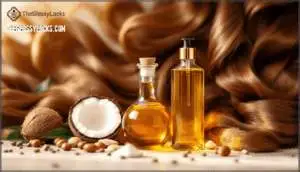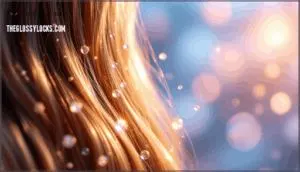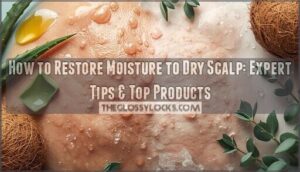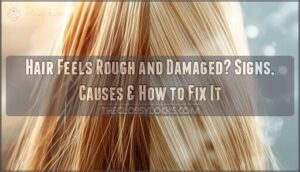This site is supported by our readers. We may earn a commission, at no cost to you, if you purchase through links.
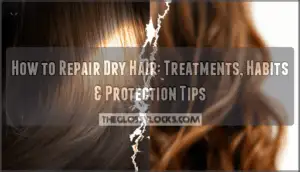
Repairing dry hair isn’t about one miracle product. It requires rebuilding protein bonds, restoring moisture balance, and protecting what you’ve fixed from future damage. The right combination of treatments and daily habits can transform even the most parched strands back to smooth, healthy hair.
Table Of Contents
Key Takeaways
- Dry hair results from broken protective barriers caused by heat styling, chemical treatments, environmental stress, and nutritional deficiencies—repairing it requires rebuilding protein bonds, restoring moisture balance, and preventing future damage through targeted treatments and habit changes.
- Ingredients like hyaluronic acid (which retains 1,000 times its weight in water), panthenol (with over 90% absorption rate), hydrolyzed keratin, and natural oils (coconut, argan, jojoba) deliver measurable results in strengthening strands, reducing breakage, and locking in moisture when used consistently.
- Daily habits matter as much as treatments—washing less frequently, switching to sulfate-free shampoo, rinsing with cool water, and using wide-tooth combs on wet hair all protect your hair’s natural oils and prevent additional moisture loss.
- Protection strategies like limiting heat tools below 300°F, wearing UPF-rated hats for UV defense, sleeping on silk pillowcases to reduce friction, and avoiding chlorine exposure stop damage before it starts, allowing your repair efforts to actually work.
What Causes Hair to Become Dry
Your hair doesn’t just dry out on its own—it happens for specific reasons. Understanding what’s working against your hair health helps you make better choices.
Let’s look at the three main culprits behind dry, damaged strands.
Heat Styling and Chemical Treatments
When you run a flat iron or blow dryer through your hair daily, or sit in a colorist’s chair for highlights, you’re basically pulling moisture out of every strand. Heat styling and chemical treatments break down the protective keratin bonds that keep your hair intact. Bleach, permanent color, and relaxers strip away natural oils, leaving hair brittle and prone to breakage.
Professional treatments like bond builders can help repair heat damage, but preventative measures—like air-drying when possible—work best.
Environmental Factors and Sun Exposure
Your hair faces a daily beating from the world around it—sun, wind, pollution, and even the water you swim in can leave it parched and dull. UV hair damage weakens the protein structure inside each strand, while pollution coats hair with residue that blocks moisture.
Hot, dry climates and seasonal dryness intensify the problem, especially with wind exposure stripping away natural oils. Chlorinated pools and saltwater worsen environmental factors affecting hair, making hair UV protection essential year-round.
Nutritional Deficiencies
What you eat directly affects your hair’s health. Iron deficiency is linked to hair shedding in up to 30% of women, and low ferritin levels slow regrowth. Zinc deficiency can lead to brittle strands and impaired keratin production. Vitamin D insufficiency, affecting about 35% of adults, can push hair into premature shedding. Biotin deficiency shows up as dry, splitting hair in 38% of women with hair loss.
Nutritional deficiencies—iron, zinc, vitamin D, and biotin—directly weaken hair structure, causing shedding and brittleness in up to 38% of women
Key mineral deficiencies that dry out hair:
- Iron and zinc – support follicle function and protein strength
- Vitamin B12 and biotin – maintain moisture and prevent breakage
- Vitamin D – regulates growth cycles and strand resilience
The role of diet in hair health can’t be overstated. Vitamin deficiencies can indeed lead to hair loss, impacting overall hair health. Hair nutrients from whole foods work better than nutritional supplements for hair alone, though hair supplements help when deficiencies are confirmed through testing.
Essential Ingredients and Treatments for Dry Hair
If your hair feels more like straw than silk, the right ingredients can make all the difference. The treatments you choose matter just as much as changing your daily habits.
Here’s what actually works to bring moisture back into damaged strands.
Moisturizing Oils (Coconut, Argan, Jojoba)
Natural oils work like a protective shield for dry hair, locking in moisture and smoothing down damaged cuticles. Coconut oil reduces protein loss and seals in hydration, while argan oil delivers lightweight nourishment without heaviness. Jojoba oil mimics your scalp’s natural sebum, balancing moisture levels.
Apply these oils as a pre-shampoo treatment once or twice weekly, or blend them for a personal approach to treating dry hair.
Hyaluronic Acid and Panthenol
Beyond typical moisturizers, hyaluronic acid and panthenol offer clinical-grade hair repair backed by measurable results. HA retains up to 1,000 times its weight in water, filling micro-cracks in porous hair to boost hydration and shine.
Panthenol penetrates deep—over 90% absorption—strengthening protein bonds and reducing breakage. Panthenol, also known as pro-vitamin B5, strengthens weakened hair by building bonds between broken proteins.
Studies show HA treatments increased hair thickness by 37.5% in 90 days, while panthenol formulations decreased hair loss substantially. Both ingredients are safe for daily use and appear in consumer trends favoring gentle, evidence-based hair care.
Protein Treatments and Bond Repair
When hair protein structure breaks down, bond repair treatments and protein penetration work together to reverse the damage. Hydrolyzed keratin and bond-builders restore hair elasticity and reduce hair breakage, with some formulas repairing up to two years of damage.
- Protein sources fill cuticle gaps, strengthening strands and improving flexibility
- Bond repair targets disulfide bonds, rebuilding internal structure after chemical damage
- Treatment limitations require repeat application—effects fade after washing, so consistent use maintains results
Professional treatments deliver stronger outcomes than most DIY options, though both can measurably reduce hair breakage when used correctly.
Deep Conditioning Hair Masks
A deep conditioning mask acts like a power nap for exhausted hair—it gives strands concentrated time to absorb moisture and repair what daily wear strips away.
Apply your hair treatment from mid-length to ends, leaving it on for 20-30 minutes (or overnight for intensive repair).
DIY hair masks with coconut oil or store-bought deep conditioning formulas both work—use them weekly for best results.
Daily Hair Care Habits to Restore Moisture
The right daily routine can make all the difference when you’re trying to bring life back to dry hair. Small shifts in how you wash, rinse, and brush can lock in moisture and prevent further damage.
Here’s what works.
Reduce Washing Frequency
Washing your hair too often strips away the natural oils your scalp produces to keep strands soft and protected. Try switching to every other day or even twice a week to restore your hydration balance.
Between washes, dry shampoo works well to absorb excess oil without disrupting scalp oil production. You can also try co-washing—using conditioner only—which cleanses gently while maintaining hair moisture.
Switch to Sulfate-Free Shampoo
Sulfates—those foaming agents in most shampoos—act like industrial-strength degreasers on your hair, yanking away natural oils faster than your scalp can replace them. Sulfate-free formulas cleanse effectively without stripping moisture, making them ideal for dry hair and scalp sensitivity.
Look for these sulfate alternatives:
- Cocamidopropyl betaine – Derived from coconut oil, it creates gentle lather quality without irritation
- Decyl glucoside – A plant-based cleanser that works across all hair types
- Sodium cocoyl isethionate – Delivers shampoo benefits while preserving your hair’s natural protective barrier
Use Cool Water for Rinsing
Hot water might feel like a relaxing end to your wash routine, but it’s actively working against your hair—forcing open the cuticle layer and letting precious moisture escape with every rinse.
Cool water does the opposite—it seals the cuticle, locking in hydration and boosting shine enhancement.
This simple shift aids frizz reduction, maintains scalp health, and strengthens hair moisture retention without extra products or effort.
Gentle Brushing Techniques
Brushing wet hair—when it’s at its weakest—can snap strands faster than any heat tool, but switching to the right technique protects your hair instead of punishing it. Use a wide-tooth comb or detangling tools designed for wet hair care, starting from the ends and working upward. Sectioning hair makes the process easier and prevents unnecessary tugging.
For dry hair, boar bristles distribute natural oils while providing gentle scalp stimulation, which aids hair breakage prevention without stress.
Protect Your Hair From Further Damage
Once you’ve built healthier habits, the next step is to keep your hair from slipping back into dryness.
That means protecting it from the daily stressors that strip moisture and weaken strands.
Here’s how to shield your hair from common sources of damage.
Limit Heat Styling Tools
Heat styling tools like flat irons, curling wands, and blow dryers repeatedly subject your hair to temperatures that can exceed 400°F, which breaks down the protein structure that keeps strands strong and moisturized.
To prevent hair damage, consider these alternative styling methods:
- Air-dry your hair whenever possible, or use the cool setting on your dryer
- Apply heat protectant sprays before any tool use to shield strands
- Keep tool temperature control below 300°F to minimize heat damage signs
Repairing heat damage takes time, so limiting exposure now protects future growth.
UV Protection and Hats
Just as heat damages hair indoors, the sun’s UV rays work against you outside, weakening strands and stripping moisture from the surface layer.
Wearing a wide-brim hat blocks harmful UV exposure and prevents hair damage at its source. Choose UPF-rated hats for measurable protection, and apply scalp sunscreen to your part line.
Hat material matters—tightly woven fabrics shield better than loose knits.
Silk Pillowcases for Overnight Care
While you’re protecting your hair from outdoor damage, your regular cotton pillowcase might be causing friction and breakage all night long.
Silk pillowcases reduce friction between strands and fabric, preserving hair hydration and preventing overnight damage. This smooth surface stops hair from snagging and splitting while you sleep.
Key silk benefits for dry hair:
- Prevents moisture loss that cotton absorbs from strands
- Reduces tangles and knots you’d otherwise brush out roughly
- Minimizes frizz and keeps cuticles smooth
- Offers skin benefits by reducing facial creases
Avoid Chlorine and Saltwater Exposure
Swimming pools and ocean water strip moisture from your hair faster than almost any other environmental factor. Chlorine and salt create a drying effect that pulls hydration directly from your strands, leaving them brittle and damaged.
Before swimming, wet your hair with clean water and apply a leave-in conditioner as a protective barrier. Afterward, rinse immediately and follow with a hydrating mask to restore lost moisture and prevent long-term hair dryness.
Frequently Asked Questions (FAQs)
How often should I trim dry hair?
Trim frequency matters more than you might think—it’s the difference between lengthening dry hair and watching it break. Professional advice recommends haircuts every six to eight weeks for preventing hair damage.
Regular trimming removes split ends before they travel upward, reducing hair breakage. This split end prevention actually aids hair growth impact by maintaining dry hair length instead of losing inches to damage.
Can hard water make hair drier?
Hard water contains hardness minerals like calcium and magnesium that create scalp buildup, preventing moisture from penetrating your hair shaft.
This buildup causes hair dryness and damage over time.
Water softeners, chelation therapy, or filter options can help reduce these effects.
Does air drying prevent hair damage?
Air drying benefits your hair like letting a wound heal naturally—it avoids heat damage. Treating dry hair means skipping blow dryers, allowing hair porosity to stabilize.
However, drying time and product usage matter for preventing hair damage during air-dry sessions.
Which hairstyles protect dry hair best?
Protective braid styles and loose bun variations reduce hair breakage by minimizing manipulation. Low manipulation styles like twists limit friction and prevent hair damage.
Before hair styling, apply scalp oiling for hydration. Hydrating hair wraps overnight lock in moisture using proper hair styling techniques.
How long until dry hair improves?
You’ll notice changes in a few days with consistent treatment, but full hair repair depends on damage severity and hair porosity.
Deep conditioning masks and protein treatments work faster when product absorption is ideal and your hair care routine complements your lifestyle factors.
Conclusion
Think about the last time you ran your fingers through truly healthy hair—that easy glide, the natural shine catching light. That’s what your strands remember, and what they can become again.
Learning how to repair dry hair means committing to consistent moisture, strategic protection, and patience with the process. Your follicles didn’t lose their ability to produce healthy strands overnight, and they won’t recover that fast either.
But with the right treatments and daily habits, you’re rebuilding resilience one strand at a time.
- https://www.futuremarketinsights.com/reports/conditioning-hair-treatments-market
- https://pmc.ncbi.nlm.nih.gov/articles/PMC3229938/
- https://www.healthline.com/health/moisturizer-on-hair
- https://www.poweredxbeautybuddy.com/blog-shared-insights/hair-repair-products-survey
- https://www.livebytheswordsalon.com/trends/best-hair-treatments-for-dry-hair

